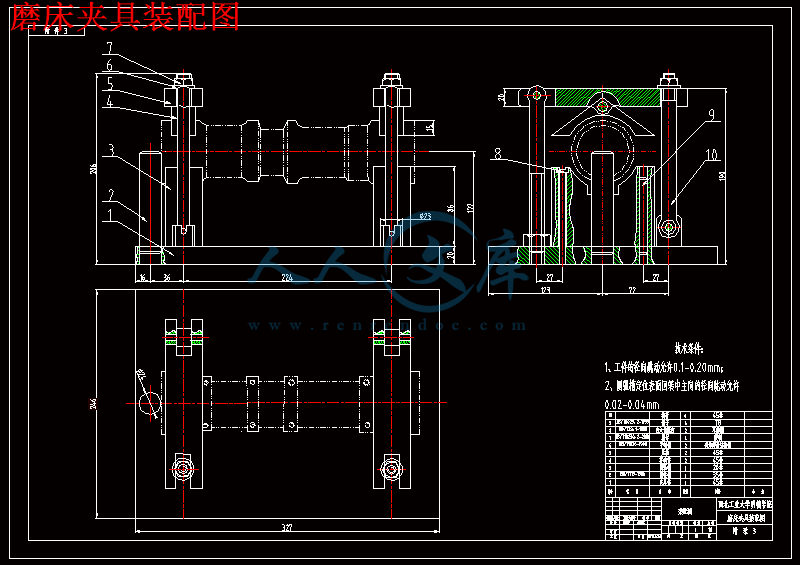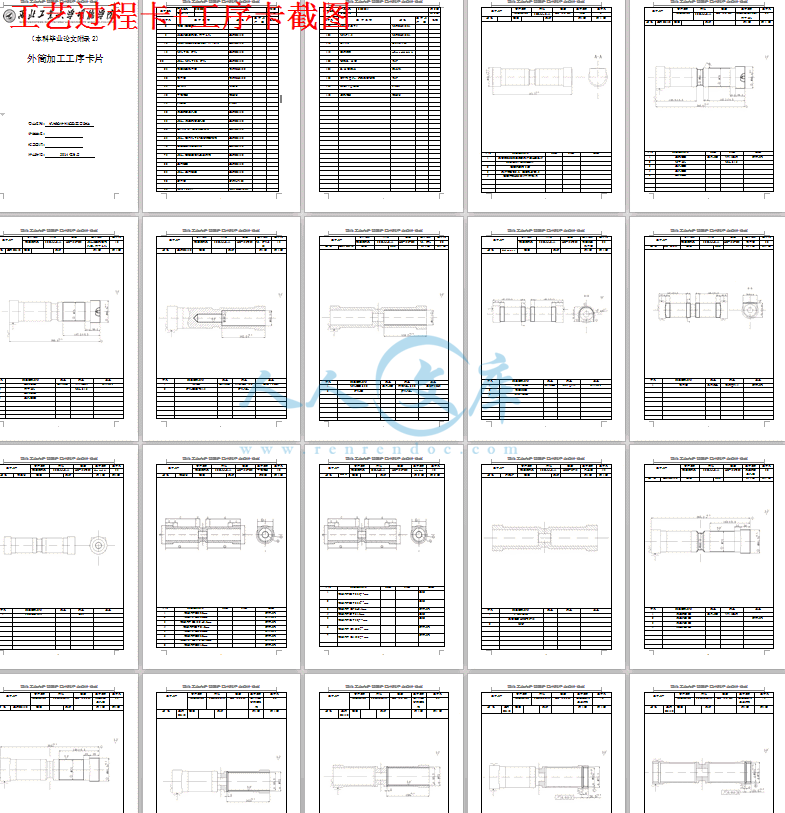摘 要
本次设计内容涉及了机械制造工艺及机床夹具设计、公差配合与测量等多方面的知识。通过对知识的综合运用,设计了外筒零件的加工工艺规程及夹具的设计。外筒加工工艺规程及磨床的夹具设计包括零件加工的工艺设计、工序设计以及磨床夹具的设计三部分。在工艺设计中要首先对外筒零件进行分析,了解外筒零件的工艺再设计出毛坯的结构,并选择好外筒零件的加工基准,设计出外筒零件的工艺路线;接着对外筒零件各个工步的工序进行尺寸计算,关键是决定出各个工序的工艺装备及切削用量;然后重点进行磨床夹具的设计,磨床夹具设计的要点,选择设计出夹具的各个组成部件,如夹紧元件、引导元件、夹具体与机床的连接部件以及其它部件;计算出夹具定位时产生的定位误差,分析夹具结构的合理性与不足之处,并在以后设计中注意改进。设计磨床夹具是为了生产过程中能方便快捷的完成磨平面工序的加工,从而提高生产效率。通过夹具设计掌握所学的机械知识,使之相互联系,进一步使理论和实践相结合,并巩固了知识点。
关键词:外筒零件,工艺规程,磨床夹具
ABSTRACT
The design content of the mechanical manufacturing technology and machine tool fixture design, tolerance matching and measurement of aspects of knowledge. Through the integrated use of knowledge, design of the outer barrel parts machining process planning and fixture design. External processing technical process and grinding machine of fixture design including parts processing process design, process design and grinding machine fixture design three parts. Must first foreign tube parts in process design were analyzed, and the outer tube parts technology to design the structure of blank, and choose good outer barrel parts processing benchmark, sticking out of the barrel parts design process; Then foreign tube parts size of each work step of the process, the key is to determine the process equipment for each process and cutting parameter; Then the grinding machine fixture design, the main points of the grinding machine fixture design, select design out of the component parts of the fixture, such as clamping components and guide components, clip specific connection with machine parts and other parts; Calculated at the exit of fixture locating position error, analysis the rationality of the fixture structure and deficiency, and pay attention to the improvement in the later design. Grinding machine fixture is designed to process that can be convenient and quick plane grinding process to complete the processing, thus improve the production efficiency. Through the knowledge of the mechanical fixture design master what they have learned, to connect with each other, further to combine theory and practice, and consolidate the knowledge.
Key words:Outside the cylinder,Process planning,Grinding machine fixture
目 录
第一章 绪 论1
第二章 工艺方案分析2
2.1 外筒的零件图的分析2
2.1.1 外筒零件结构特点3
2.1.2 外筒零件的作用3
2.1.3 外筒零件的工艺分析3
第三章 外筒零件的工艺规程设计4
3.1 确定毛坯4
3.1.1 毛坯的选择4
3.1.2 绘制毛坯图5
3.2 拟定工艺路线5
3.2.1 各表面加工方法5
3.2.2 定位基准的选择16
3.2.3 加工阶段的划分17
3.2.4 工序的集中与分散17
3.2.5 热处理工序的安排18
3.2.6 辅助工序的安排19
3.2.7 重要工序的分析19
3.3 加工余量的确定21
3.4 尺寸链计算22
第四章 外筒零件磨平面工序的磨床夹具设计24
4.1 定位装置的设计24
4.2 夹紧装置的设计24
4.3 绘制夹具总图25
4.4 夹具操作过程简述25
4.5 夹具精度校核25
第五章 结 论27
参考文献28
致 谢29
毕业设计小结30
附 录31
第一章 绪 论
机械制造业是制造具有一定形状位置和尺寸的零件和产品,并把它们装备成机械装备的行业。机械制造业的产品既可以直接供人们使用,也可以为其它行业的生产提供装备,社会上有着各种各样的机械或机械制造业的产品。我们的生活离不开制造业,因此制造业是国民经济发展的重要行业,是一个国家或地区发展的重要基础及有力支柱。从某中意义上讲,机械制造水平的高低是衡量一个国家国民经济综合实力和科学技术水平的重要指标。机械加工(简称“机加”)是制造技术中的重要组成部分。随着我国经济不断发展,产业结构的调整,企业改革不断深化。目前,我国制造技术水平与先进国家相比还有较大差距,为适应我国工业发展,在总结经验和加强基础研究上都加大投入,提高加工工艺水平,成为发展工业的重要环节之一。
随着近年来科学技术以及工业经济的飞速发展,合金结构钢的需求日益增多,使合金结构钢的加工性研究也随之深入。合金结构钢的广泛应用促进了合金结构钢加工技术的发展,同时加工技术的发展又拓展了合金结构钢的应用领域,因此合金结构钢的加工技术正成为研究的热点之一。而在对合金结构钢材料进行加工的过程中有许多内容值得我们进行探究,例如加工温度、切削表面、切削内应力等等。
本文的主要内容是外筒零件的加工工艺与磨床夹具设计。它的整个加工过程中涉及到毛坯的选择、加工余量的计算、工艺路线的确定、机床夹具定位装置的设计和辅助工序的选择等内容。叙述了外筒零件机械加工工艺过程,从以下几个方面展开研究:
1.外筒零件的结构特点和工艺分析;
2.零件的工艺规程设计;
3.加工中刀具的选择及应用;
4.夹具的设计及注意事项。




 川公网安备: 51019002004831号
川公网安备: 51019002004831号